 Audubon realized this tiny finch was a previously unknown variety when he heard its song. The elusive bird proved difficult to trap, though. When Tom Lincoln finally shot one, Audubon named it Tom’s finch, “In honor of our friend Lincoln, who was a great favorite among us.” It is known today as a Lincoln’s sparrow. Image credit: Lincoln’s sparrow (Melospiza lincolnii), by JJ Audubon, June 27, 1833, watercolor and graphite on paper, 23”x29”; #1863.193. Collection of the New York Historical Society/Oppenheimer Editions. www.nyhistory.orgOld friends, a new ship, wild country, and a mythic bird that had been on endangered species lists for 280 years—these are some of the things that brought naturalist John James Audubon to Maine in the spring of 1833.
Audubon realized this tiny finch was a previously unknown variety when he heard its song. The elusive bird proved difficult to trap, though. When Tom Lincoln finally shot one, Audubon named it Tom’s finch, “In honor of our friend Lincoln, who was a great favorite among us.” It is known today as a Lincoln’s sparrow. Image credit: Lincoln’s sparrow (Melospiza lincolnii), by JJ Audubon, June 27, 1833, watercolor and graphite on paper, 23”x29”; #1863.193. Collection of the New York Historical Society/Oppenheimer Editions. www.nyhistory.orgOld friends, a new ship, wild country, and a mythic bird that had been on endangered species lists for 280 years—these are some of the things that brought naturalist John James Audubon to Maine in the spring of 1833.
He was planning an expedition to observe, collect samples, and draw North Atlantic birds for his monumental work The Birds of America. Among other birds, he hoped to find a Great Auk—the totemic northern penguin that stood nearly three feet high and weighed more than 10 pounds. The auk’s numbers had been declining across its range since the 16th century; its superb down was used for pillows and coverlets, and its eggs were a source of protein. Despite all of his birding, Audubon had never seen one alive.
This was not his first trip downeast. Accompanied by his wife, Lucy, and two sons, Victor Gifford, 21, and John Woodhouse, 19, Audubon had spent several weeks in Maine the previous fall. The family stayed in Dennysville with Judge Theodore Lincoln and his family.
Judge Lincoln lived near the head of the tide on the winding Dennys River, which flows out of Meddybemps Lake through spruce and fir woods to Cobs- cook Bay. His father, General Benjamin Lincoln, bought 10,000 acres of land after the Revolution—land seized from the British who seized it from the French who seized it from the Wabanaki—in what is now Washington County. Built in 1787 and listed on the National Register of Historic Places, the Lincoln House still stands overlooking the river that is often dotted with bobbing Canada geese just off of Route 1.
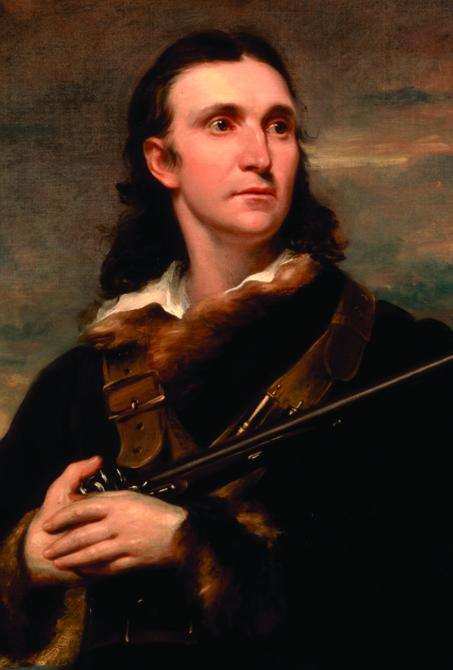 John Syme did this painting of Audubon in 1826 in Edinburgh where Audubon had traveled to try and raise support for The Birds of America. Image from White House Historical CollectionAt the time of his visits, Audubon was at work on his masterpiece The Birds of America, with the goal of producing a painting of each bird species on the continent.
John Syme did this painting of Audubon in 1826 in Edinburgh where Audubon had traveled to try and raise support for The Birds of America. Image from White House Historical CollectionAt the time of his visits, Audubon was at work on his masterpiece The Birds of America, with the goal of producing a painting of each bird species on the continent.
Since there were no practical field cameras at the time, Audubon’s practice was to kill his subjects with fine shot so as not to disfigure them, and then to pose them using strings and wires to make them look life-like. Even though he and his helpers killed hundreds upon hundreds of birds in the course of this work, Audubon’s journals record a broad sympathy for animals and a respect for those who treated them humanely.
When Audubon returned downeast in 1833, he was headed to Labrador, via Eastport, with his son John Woodhouse. Lucy Audubon, who had accompanied her family during the previous summer’s visit, stayed in Boston. She was an independent and capable woman who shepherded her erratic and eccentric husband through the arduous process of launching his masterpiece of ornithology. She and he shared a lifelong love of nature and a taste for travel. Had women been more welcome aboard working ships in those days, Lucy might have gone with them to see the wonders they would meet, and just to keep an eye on things.
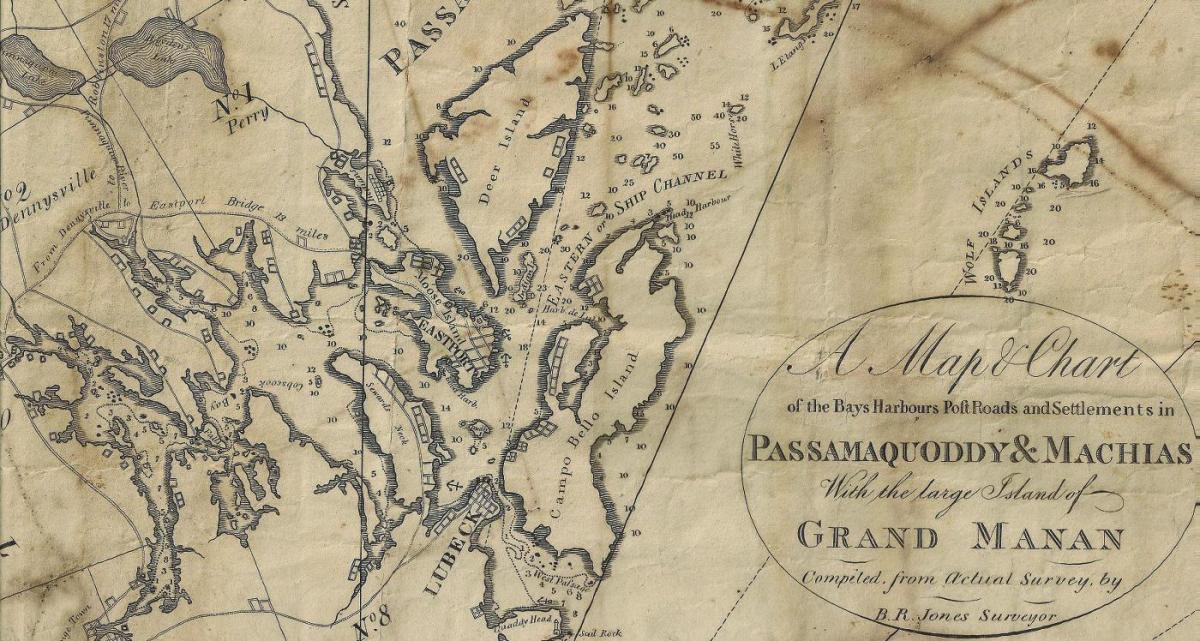 This map was drawn by Benjamin R. Jones, who was from the Hingham area, near Quincy, Massachusetts. Upon seeing the map (originally published in 1811), Abigail Adams reportedly observed, “I always knew that boy would make something of himself one day.” This version was updated in 1824. Courtesy Dennys River Historical Society
This map was drawn by Benjamin R. Jones, who was from the Hingham area, near Quincy, Massachusetts. Upon seeing the map (originally published in 1811), Abigail Adams reportedly observed, “I always knew that boy would make something of himself one day.” This version was updated in 1824. Courtesy Dennys River Historical Society
 Audubon described the captain of the Ripley, Henry T. Emery (shown here in an undated oil painting), as a “capital seaman.” Courtesy Tides Institute and Museum of ArtAudubon chartered the 71-foot schooner Ripley—106 tons and built in 1832—for the voyage. He described the captain, Henry Tilton Emery, as “a first-rate man, active, industrious and pleasing in his manners… a capital seaman.” Emery was 50 years old at the time, but kept up with the younger men who scrambled over the rocks in search of nests and specimens. In later life, Emery became a lawyer and representative to the Maine legislature.
Audubon described the captain of the Ripley, Henry T. Emery (shown here in an undated oil painting), as a “capital seaman.” Courtesy Tides Institute and Museum of ArtAudubon chartered the 71-foot schooner Ripley—106 tons and built in 1832—for the voyage. He described the captain, Henry Tilton Emery, as “a first-rate man, active, industrious and pleasing in his manners… a capital seaman.” Emery was 50 years old at the time, but kept up with the younger men who scrambled over the rocks in search of nests and specimens. In later life, Emery became a lawyer and representative to the Maine legislature.
The ship’s crew also included “a capital cook, although he was a little too fond of the bottle,” according to Audubon. Certainly he was not the first ship’s cook to sample the eau de vie while on the job, nor the last.
Audubon also brought his own crew with him, including his son; Thomas Lincoln, who had been his birding companion the previous summer; William Ingalls and George Shattuck of Boston; and Joseph Coolidge of Eastport. The job of these young men was to go out in small boats and bring back birds they had shot as well as specimens of plants and other wildlife.
On June 6, 1833 at 1 p.m., while “the batteries of the garrison and the cannon of the revenue cutter saluted us,” and the entire male population of Eastport reportedly turned out to see them go, Captain Emery and crew cast off and headed up Friar Roads and out through the Lubec Narrows toward Grand Manan. Ingalls reported that the water was so clear they could see lobsters on the ocean bottom.
The Audubon contingent had space for sleeping and working below decks. The artist had a large table immediately under the hatch where there was some daylight for taxidermy and for drawing. Unfortunately, the hatch had to be closed in bad weather, throwing the hold into darkness, and they encountered a lot of bad weather.
A week into the voyage they approached the Magdalen Islands in the Gulf of St. Lawrence, where they scouted the rocks and beaches for birds. Audubon reported, “Suddenly [we came] plump upon one of God’s best finished jewels, a woman. She saw us first, for women are always keenest in sight and sympathy, in perseverance and patience, in fortitude, and love, and sorrow, and faith, and, for aught I know, much more.”
Audubon also noted on the same day, “The piping plover breeds here—shot two males and one female; so plaintive is the note of this interesting species that I feel great aversion to killing them.”
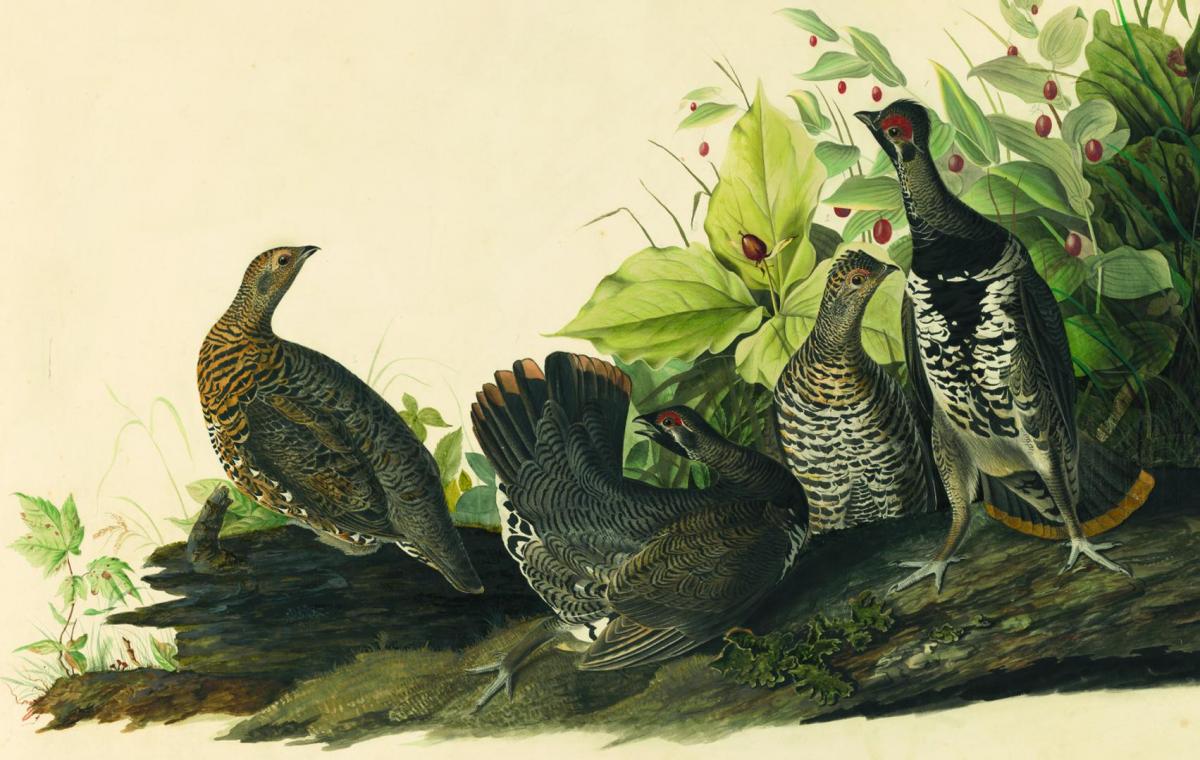 Although he had been told spruce partridge or spotted grouse were common, Audubon had to make two trips into the Dennysville woods before finally finding one in a swamp. He wrote, “We sank at every step or two up to the waist, our legs stuck in the mire, and our bodies squeezed between the dead trunks and branches of trees, the minute leaves of which insinuated themselves among my clothes, and nearly blinded me.” Image credit: Spruce Grouse (Canachites Canadensis), JJ Audubon, 1832; watercolor, graphite, pastel, black ink, and gouache with selective glazing and scratching out on paper, laid on card; paper 25”x35 7/16”; #1863.17.176. Collection of the New York Historical Society/Oppenheimer Editions. www.nyhistory.org
Although he had been told spruce partridge or spotted grouse were common, Audubon had to make two trips into the Dennysville woods before finally finding one in a swamp. He wrote, “We sank at every step or two up to the waist, our legs stuck in the mire, and our bodies squeezed between the dead trunks and branches of trees, the minute leaves of which insinuated themselves among my clothes, and nearly blinded me.” Image credit: Spruce Grouse (Canachites Canadensis), JJ Audubon, 1832; watercolor, graphite, pastel, black ink, and gouache with selective glazing and scratching out on paper, laid on card; paper 25”x35 7/16”; #1863.17.176. Collection of the New York Historical Society/Oppenheimer Editions. www.nyhistory.org
For sheer grandeur, Gannet Rock (now the Bird Rock Ecological Preserve) was surely the most spectacular sight of the entire expedition. This promontory rises hundreds of feet above the rough waters of Cape St. Mary’s, Newfoundland, and is covered with tens of thousands of gulls, gannets, guillemots, terns, and other seabirds. Audubon wrote, “I thought it covered with snow to a depth of several feet… [But] what we saw was not snow, but gannets! …a mass of birds of such size that I had never before laid eyes upon. The whole of my party stood astounded and amazed, and all came to the conclusion that such a sight was of itself sufficient to invite any one to come across the Gulf to view at this season.”
Unfortunately, Labrador did not turn out to be the paradise of rare birds Audubon had been hoping to find. There were great numbers of more common birds, but how many herring gulls or eider ducks does one need to see in a lifetime? Even in July the weather was dreary or stormy with temperatures in the 40s and 50s and rain aplenty. Worst of all were the hordes of biting insects: “musquitos,” black flies, “Caribou flies,” and several other varieties which seemed to thrive even under these bleak conditions.
 Audubon wrote that the numbers of surf ducks in Labrador exceeded all his previous conceptions, but he was only able to find one nest. He shot the female and took her five eggs. (Image credit) Surf scoter (Melanitta perspicillata), JJ Audubon, 1833; watercolor, graphite, pastel, black chalk, and black ink with touches of gouache on paper, laid on card; 20 11/16”x29 7/16”; #1863.17.317 Collection of the New York Historical Society/Oppenheimer Editions. www.nyhistory.orgWilliam Ingalls, one of the young men on the expedition, recalled in a letter he wrote in 1903 at the age of 90, “Were you ever anywhere in the company of black flies? Well, don’t seek them unless you wish to get a large number of them to put in a bottle of alcohol. George Shattuck came on board one afternoon, face and neck a mass of bites. The black flies are beastly and can easily draw one on to suicide.” This was his abiding memory of the expedition he had endured 70 years before.
Audubon wrote that the numbers of surf ducks in Labrador exceeded all his previous conceptions, but he was only able to find one nest. He shot the female and took her five eggs. (Image credit) Surf scoter (Melanitta perspicillata), JJ Audubon, 1833; watercolor, graphite, pastel, black chalk, and black ink with touches of gouache on paper, laid on card; 20 11/16”x29 7/16”; #1863.17.317 Collection of the New York Historical Society/Oppenheimer Editions. www.nyhistory.orgWilliam Ingalls, one of the young men on the expedition, recalled in a letter he wrote in 1903 at the age of 90, “Were you ever anywhere in the company of black flies? Well, don’t seek them unless you wish to get a large number of them to put in a bottle of alcohol. George Shattuck came on board one afternoon, face and neck a mass of bites. The black flies are beastly and can easily draw one on to suicide.” This was his abiding memory of the expedition he had endured 70 years before.
Thomas Lincoln recorded his sentiments in his journal after returning home. “We were told that the sea-birds of nearly all the kinds that live on the coast of Maine were so abundant at Labrador that we would have no difficulty at anytime of getting any number we might want,” he wrote. “But instead of all this, the birds excepting two or three species were exceedingly rare.” Lincoln, too, remarks about the horrid biting insects.
Audubon’s journals rarely contain such grumblings. His approach to each day was one of excitement. Maybe he felt badly about Lincoln’s complaints, particularly since Lincoln’s father had been so hospitable to the Audubons. He named one of the two new species found on the expedition the Lincoln’s sparrow as a tribute to the family, as well as a tribute to young Lincoln who had caught the specimen.
Even the artist himself acknowledged that with only two new species identified and only 17 drawings completed, it would be hard to call the expedition a great success. And yet, the birdman poured out his heart in exhilaration in his journal entry for July 2: “The country, so wild and grand, is of itself enough to interest anyone in its wonderful dreariness. Its mossy, gray-clothed rocks, heaped and thrown together as if by chance, in the most fantastical groups imaginable, huge masses hanging on minor ones as if about to roll themselves down from their doubtful situations into the depths of the sea beneath. Bays without end sprinkled with rocky islands of all shapes and sizes.” He continues in this same tone, concluding, “All—all is wonderfully grand, wild—aye, and terrific.”
The artist and his young crew continued to Halifax and St. John and then back to Eastport, disembarking on the last day of August 1833. Audubon never saw a Great Auk in the wild. The last breeding pair was killed in 1844 off the coast of Iceland by bounty hunters who sought a trophy to grace the drawing room of a wealthy Englishman. America’s original ornithologist had to borrow a dusty, stuffed museum specimen to use as his model for The Birds of America.
But his passion for wild birds and wild country kindled a fire in the hearts of thousands who honor his name and his memory. In this labor of love he may have killed his hundreds, but his disciples, by their passion, have surely saved many thousands more.
For more about the New-York Historical Society: www.nyhistory.org
Rob McCall is an author and naturalist who lives on Moose Island in Cobscook Bay.
His most recent book is Great Speckled Bird: Confessions of a Village Preacher.
Maine Sightings
These are birds that the ornithologist John James Audubon mentioned collecting or observing during his various expeditions to Maine. Note that the names used here are those used today, not the ones used by Audubon.
- Bonaparte’s gull
- Boreal owl
- Bufflehead
- Common loon
- Dovekie
- Iceland gull
- Lincoln’s sparrow
- Northern goshawk
- Pectoral sandpiper
- Ring-billed gull
- Ruddy turnstone
- Spruce grouse
- Surf scoter
- Tufted puffin
- White-winged crossbill
The Dennysville Connection
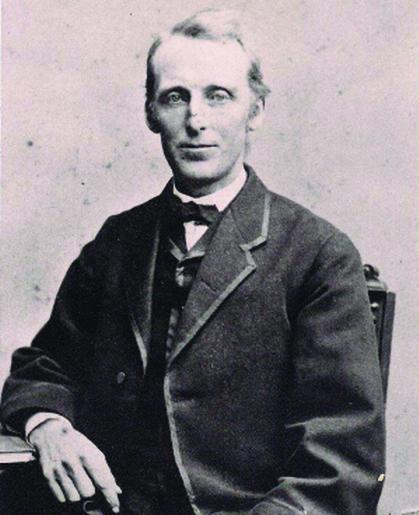 Tom Lincoln was about 20 when he went on the Labrador expedition. An avid birder, he had taken Audubon bird watching during an earlier visit to Maine. Photo courtesy Dennys River Historical SocietyWhen John James Audubon first visited downeast Maine in 1832, he stayed with the Lincoln family in Dennysville. He was introduced by one of his financial backers, Dr. George Shattuck, who knew the family from Massachusetts where they also owned property, according to Colin Windhorst, a historian and officer at the historical society in Dennysville.
Tom Lincoln was about 20 when he went on the Labrador expedition. An avid birder, he had taken Audubon bird watching during an earlier visit to Maine. Photo courtesy Dennys River Historical SocietyWhen John James Audubon first visited downeast Maine in 1832, he stayed with the Lincoln family in Dennysville. He was introduced by one of his financial backers, Dr. George Shattuck, who knew the family from Massachusetts where they also owned property, according to Colin Windhorst, a historian and officer at the historical society in Dennysville.
Accompanied by his wife and two sons, Audubon arrived in late August and spent a month traveling around the region. That visit, as well as the ornithologist’s visit the following year on his way to Labrador, will form the basis for an exhibit this summer at the Academy/Vestry Museum in Dennysville. The Dennys River Historical Society organized the show in cooperation with the Lincoln House.
In addition to sketching, Audubon wrote several essays while he was in Maine in 1832, including a powerful description of lumbermen breaking up a logjam to move timber down the river to Lincoln’s mill along the Dennys River.
“It seemed to me as if I witnessed the rout of a vast army, surprised, overwhelmed, and overthrown,” he wrote.
Audubon and his sons went birding with Lincoln’s son, Thomas, looking for what he called Spruce Partridge or Canada grouse—what we today know as spruce grouse. After a hard day of bushwhacking in the woods with no success, the group headed home. On the way they passed some men haying in a field near the village who had seen a “fine covey” of the birds just 30 minutes after the Audubons had gone by that morning. “We were too much fatigued to go in search of them,” wrote Audubon, who was later able to obtain some samples of the bird from another source.
Audubon and his sons also traveled up to Houlton, Maine, and across the Canadian border to New Brunswick, returning to Bangor along the route of what is today Interstate 95, according to Windhorst.
When Audubon returned the following year he stayed in Eastport instead of with the Lincolns and Lucy remained at home in Boston. The historical society owns a letter he sent on May 16 in which he described preparations for the trip. That letter, as well as other artifacts, will be on display in the exhibit this summer, Windhorst said.
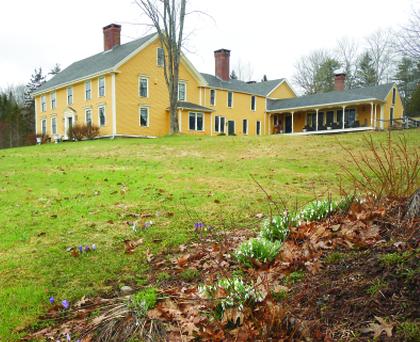 The Lincoln family’s house in Dennysville looks today very much as it did during the family’s 150 years there. Photo by Rob McCallA new book, Audubon: America’s Greatest Naturalist and His Voyage of Discovery to Labrador by Peter B. Logan, is due to be published this summer by Ashbryn Press. Copies will be available at the Dennysville museum.
The Lincoln family’s house in Dennysville looks today very much as it did during the family’s 150 years there. Photo by Rob McCallA new book, Audubon: America’s Greatest Naturalist and His Voyage of Discovery to Labrador by Peter B. Logan, is due to be published this summer by Ashbryn Press. Copies will be available at the Dennysville museum.
The Academy/Vestry Museum is open Saturday afternoons, and by appointment from Memorial Day through Labor Day. For more information, call 207-726-3905.
—Polly Saltonstall






